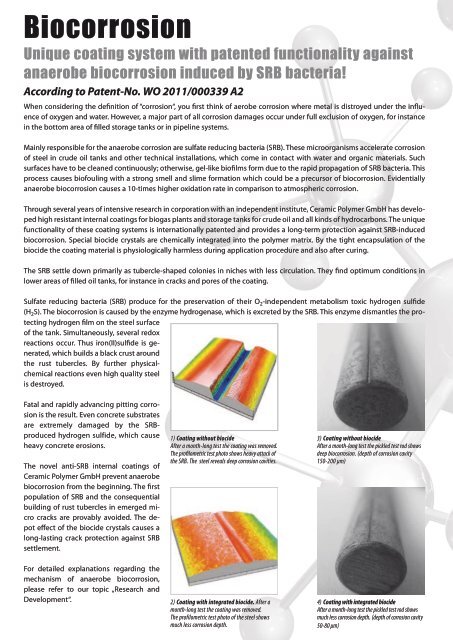i n n o v a t i v e ⢠C o a t i n g s
You also want an ePaper? Increase the reach of your titles
YUMPU automatically turns print PDFs into web optimized ePapers that Google loves.
Biocorrosion<br />
Unique coating system with patented functionality against<br />
anaerobe biocorrosion induced by SRB bacteria!<br />
According to Patent-No. WO 2011/000339 A2<br />
When considering the definition of “corrosion“, you first think of aerobe corrosion where metal is distroyed under the influence<br />
of oxygen and water. However, a major part of all corrosion damages occur under full exclusion of oxygen, for instance<br />
in the bottom area of filled storage tanks or in pipeline systems.<br />
Mainly responsible for the anaerobe corrosion are sulfate reducing bacteria (SRB). These microorganisms accelerate corrosion<br />
of steel in crude oil tanks and other technical installations, which come in contact with water and organic materials. Such<br />
surfaces have to be cleaned continuously; otherwise, gel-like biofilms form due to the rapid propagation of SRB bacteria. This<br />
process causes biofouling with a strong smell and slime formation which could be a precursor of biocorrosion. Evidentially<br />
anaerobe biocorrosion causes a 10-times higher oxidation rate in comparison to atmospheric corrosion.<br />
Through several years of intensive research in corporation with an independent institute, Ceramic Polymer GmbH has developed<br />
high resistant internal coatings for biogas plants and storage tanks for crude oil and all kinds of hydrocarbons. The unique<br />
functionality of these coating systems is internationally patented and provides a long-term protection against SRB-induced<br />
biocorrosion. Special biocide crystals are chemically integrated into the polymer matrix. By the tight encapsulation of the<br />
biocide the coating material is physiologically harmless during application procedure and also after curing.<br />
The SRB settle down primarily as tubercle-shaped colonies in niches with less circulation. They find optimum conditions in<br />
lower areas of filled oil tanks, for instance in cracks and pores of the coating.<br />
Sulfate reducing bacteria (SRB) produce for the preservation of their O2-independent metabolism toxic hydrogen sulfide<br />
(H2S). The biocorrosion is caused by the enzyme hydrogenase, which is excreted by the SRB. This enzyme dismantles the protecting<br />
hydrogen film on the steel surface<br />
of the tank. Simultaneously, several redox<br />
reactions occur. Thus iron(II)sulfide is generated,<br />
which builds a black crust around<br />
the rust tubercles. By further physicalchemical<br />
reactions even high quality steel<br />
is destroyed.<br />
Fatal and rapidly advancing pitting corrosion<br />
is the result. Even concrete substrates<br />
are extremely damaged by the SRBproduced<br />
hydrogen sulfide, which cause<br />
heavy concrete erosions.<br />
The novel anti-SRB internal coatings of<br />
Ceramic Polymer GmbH prevent anaerobe<br />
biocorrosion from the beginning. The first<br />
population of SRB and the consequential<br />
building of rust tubercles in emerged micro<br />
cracks are provably avoided. The depot<br />
effect of the biocide crystals causes a<br />
long-lasting crack protection against SRB<br />
settlement.<br />
For detailed explanations regarding the<br />
mechanism of anaerobe biocorrosion,<br />
please refer to our topic „Research and<br />
Development“.<br />
1) Coating without biocide<br />
After a month-long test the coating was removed.<br />
The profilometric test photo shows heavy attack of<br />
the SRB. The steel reveals deep corrosion cavities.<br />
2) Coating with integrated biocide. After a<br />
month-long test the coating was removed.<br />
The profilometric test photo of the steel shows<br />
much less corrosion depth.<br />
3) Coating without biocide<br />
After a month-long test the pickled test rod shows<br />
deep biocorrosion. (depth of corrosion cavity<br />
150-200 µm)<br />
4) Coating with integrated biocide<br />
After a month-long test the pickled test rod shows<br />
much less corrosion depth. (depth of corrosion cavity<br />
50-80 µm)


